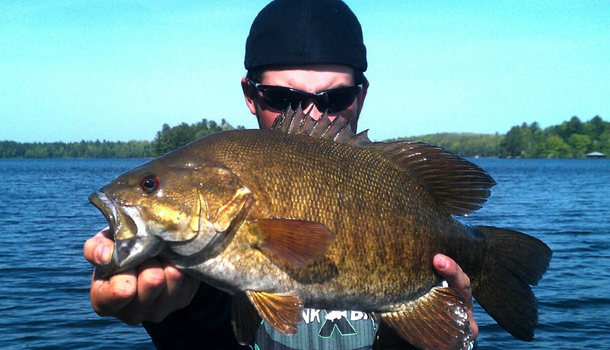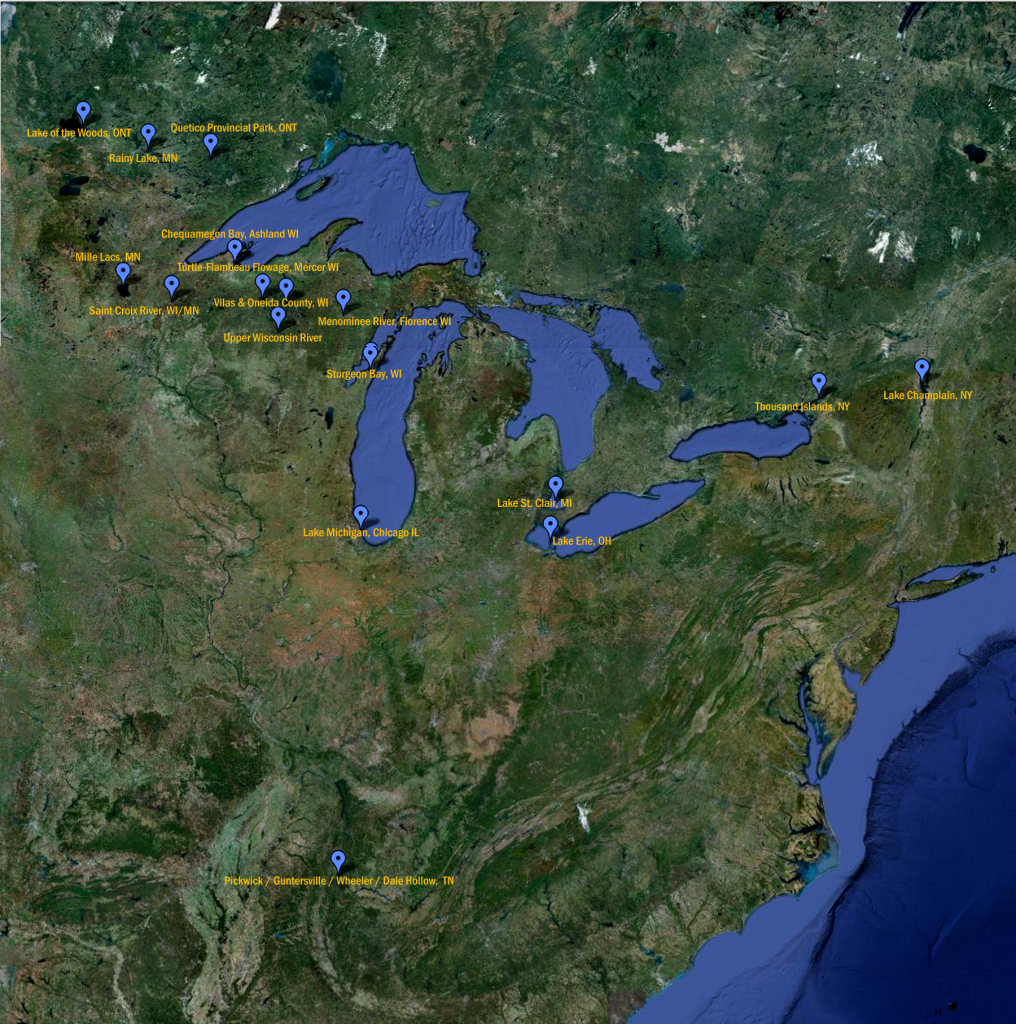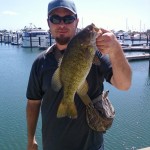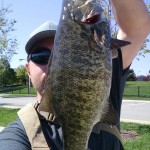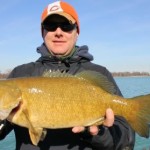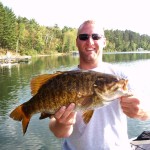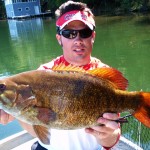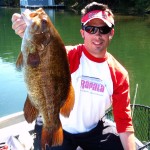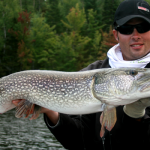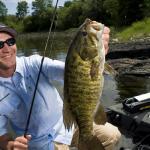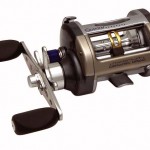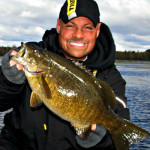Whether I’ve been there or not, I showcase a complete list of trips and destinations, and bucket lists that trophy smallmouth bass anglers should consider for 2013 and beyond.
Smallmouth bass are undoubtedly my favorite species of freshwater gamefish. From the sophisticated gear and tackle, to the techniques and pursuit, and angling battles and their sexy looks, nothing tickles my fancy more than these fish. I make it a priority to fish for smallmouth bass whenever the opportunity arises. However, I’m not always after smallmouth bass as a general species in particular. What I frequently pursue are big smallmouths that reside in challenging fisheries capable of rearing the next state records and even possibly world records. To be straightforward, I am an OCD smallmouth angler; one who is obsessed and addicted with the largest specimens that can possibly be caught.
I’ve frequently written about my favorite smallmouth seasonal periods and specific techniques. However, one subject I have failed to showcase in recent years is my favorite big fish destinations and bucket list of must-fish places to visit. As a part time resident of the centralized Midwestern location of Chicago, IL, I have many fantastic drive-to smallmouth fisheries located in every geographical direction. With places to the north, south, east, and west, it’s unbelievable how I’ve failed to cover an interestingly ridiculous subject that I can write about endlessly.
Finding ourselves in an internet and technological age where access and information to fisheries is more accessible than ever before, the angler’s ability to locate big fish has become increasingly easier. It’s difficult to find a trophy honey hole that has yet to be exploited by the masses of serious smallmouth anglers. Despite the rarity of such places, every renowned destination and fishery in North America presently seems to be known to everyone and continually kicks out loads of big fish.
My compiled list of top ten smallmouth bass trips and destinations has a few things in common, which are personally important to me: The abilities to produce sustainable boatloads of trophy fish; Public access without heavy angling pressure; Minimal travel time and the fewest expenses so that it’s easier on the pocketbook; and record fish size potential. Because I haven’t been everywhere nor seen everything yet, I have divided my selections between places I have fished, and places I must fish soon. Along with fishery information and some photos to back it up, I also include some informational websites and guide listings for each location, so you have no excuse not to start planning.
Part 1 – My Top Destinations… So far
5 – Lake Michigan, Illinois and Northern Indiana

Bryan Blazek with a 6 pound Lake MIchigan smallmouth bass that wasn’t far off from being the next Illinois state record. April, 2012 photograph.
Located within 30 minutes from me, from the shores of downtown Chicago through the industrial ports of Northern Indiana, Southern Lake Michigan offers plentiful year-round smallmouth bass opportunities. It is the best local fishing as it gets for me. Public access is plenty and the location is close.
Predominantly a shallow water environment with very little natural structure and a bottom composition of nothing more than sand, local municipalities have developed the lake’s southern basin into ideal smallmouth bass habitat with man-made structures that includes parks, piers, beaches, boat slips, artificial reefs, rip rap, and break walls.
Captain Ralph Steiger, of Hammond, Indiana, guides the southern basin of Lake Michigan on a year-round basis and suggests that the smallmouth bass fishing is as good as it has ever been with peak fishing taking place in spring and summer. Due to several forage options and the lake’s continuously improving water clarity, it is important to match the hatch accordingly with natural presentations. “In early spring mimic shad, shiners, smelt and alewives. In later spring thru early fall mimic gobies. Then later in fall during colder water, both patterns can work at any time. Keep it simple and you will catch fish,” he says. On the lake, anglers will typically fish with goby imitators and tubes, and baitfish representations which include soft and hard jerkbaits.
During spring and summer, Lake Michigan smallmouths are a numbers game with several fish in the 14 to 18 inch range caught by shore bound and boat anglers. Unsurprising to the Great Lakes, there are significant numbers of big fish out there as it has been proven by Steiger and his clients. Four and five pounders are available throughout the warm weather months, including good opportunities of fish surpassing the Illinois state record 6lb 7oz. mark. Captain Ralph Steiger – www.captainsteiger.com
4 – Wisconsin River, Wisconsin

A double of Wisconsin River smallmouth bass by Andrew Ragas and Jacob Saylor – May, 2012.
No matter where you live in Wisconsin, you are never more than an hour’s drive away from superb smallmouth bass fishing. Regarded as “America’s Hardest Working River,” the Wisconsin River is famous for containing and producing healthy, under fished populations of trophy smallmouth bass. Beginning in the river town of Portage, Wisconsin, just follow state highway 51 northward where you will eventually have access to the river at every exit you explore. The river is so easy to find that surprisingly few anglers ever spend time doing it.
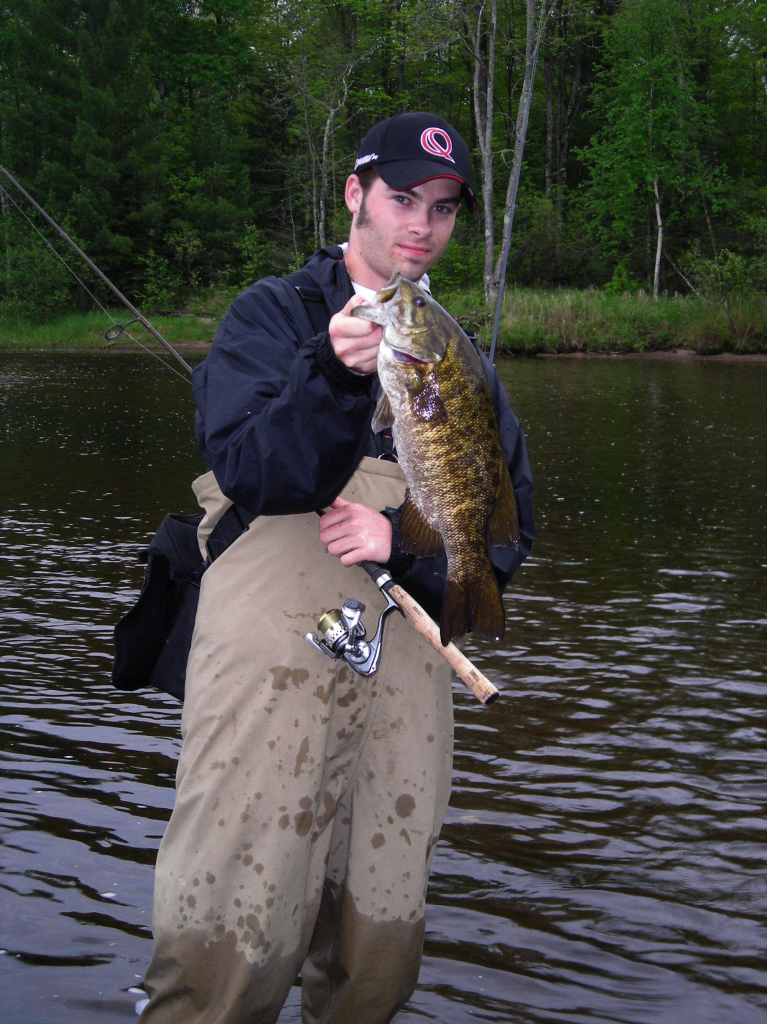 As it begins at its headwaters of Lac Vieux Desert on Michigan’s U.P. border, resembling more of a large creek that winds its way through the wild northern wilderness reaches of the state in Vilas and Oneida counties, the character of the river changes considerably the further downstream it’s traveled. It eventually transitions into a large river system full of impoundments before it merges into the mighty Mississippi.
As it begins at its headwaters of Lac Vieux Desert on Michigan’s U.P. border, resembling more of a large creek that winds its way through the wild northern wilderness reaches of the state in Vilas and Oneida counties, the character of the river changes considerably the further downstream it’s traveled. It eventually transitions into a large river system full of impoundments before it merges into the mighty Mississippi.
Wherever fished, the Wisconsin River is a boating and wade fishing minefield, but anglers willing to accept its challenging terrain don’t mind. These habitat-infested areas of wood, rocks, boulders, and abundant riffles are always loaded with willing smallmouth bass and contain the best fishing when located furthest away from easy access. Peak period fishing on the wild Wisconsin generally takes place from the season opener in May through late summer before fish begin migrating back for the wintering months into the flowages and the deep channels that can be accessed by boat only.
50 to 100 fish days are possible earlier in the year, with productivity gradually leveling out by mid-summer. Average fish lengths typically range from 14 to 18 inches with several regularly surpassing 19 and 20 inches – including the 22 inch brute I caught a few years back. Strict bag limits, a catch and release spring season, and conservation and water quality regulations have transformed this river into a top fishing destination that is truly under fished and far from ever becoming exploited. Wisconsin Angling Adventures – http://www.wisconsinanglingadventures.com
3 – Vilas and Oneida County, Wisconsin

Smallmouth bass of this magnitude have become increasingly more abundant throughout Northern Wisconsin thanks to modern fisheries management practices and conservation of trophies.
Since the turn of the 20th century when loggers and lumberjacks chopped their way to the north, the Lakeland area of Vilas and Oneida counties has been a storied land of legendary fishing filled with endless opportunity. In recent years, however, the fishing has become even more legendary and compelling for its abundant smallmouth bass fisheries and its few anglers that pursue them. I am lucky enough to call this place home.
This region contains the largest concentration of freshwater lakes in the world. With over 3,000 different places to pick and choose from, chances are good for fantastic smallmouth bass fishing. They’re so good that catching numbers of fish in the 4 to 6 pound range has become the seasonal norm for me.
Big smallmouth bass are regularly caught spring through fall on crayfish and pelagic baitfish oriented presentations, but if you want to catch the biggest and most exciting fish of the year, concentrate your efforts around the Minocqua, Boulder Junction, Manitowish Waters, and Lac Du Flambeau areas where the selection of lakes are plentiful and diverse, and the general smallmouth populations run large.
Peak fishing takes place from mid-May and lasts through June. It’s quite good through fall too, which is grossly underrated in my opinion. Throughout the open water season, anglers will often find themselves in hot streaks that cannot be ignored. 50 to 100 fish days are always possible including an epic 120 fish day that was enjoyed in May, 2012. Abundant catches of 16 to 20 inch bass are the average, including yearly improvements in the availability of fish surpassing 20 inches. In recent years, anglers have been flirting with the Wisconsin state record, as smallmouth bass surpassing 7 pounds and reaching up to 8 and a half pounds have been caught, documented, and released.
Thanks to the mandatory catch and release spring season, and strict harvest regulations on a number of trophy managed bodies of water, populations have expanded, big fish are more abundant than ever before, and catch rates have become outrageous if you hit your spots at the right time. If the new Wisconsin state record is broken, there’s a great chance it’s coming from one of the inland lakes located within this region. Fish Minocqua – http://www.fishingminocqua.com
2 – Turtle Flambeau Flowage, Wisconsin

TFF smallmouths are exceptionally heavy fish for their length, and robust in girth. They’re a unique genetic strain of smallmouth that I have seen nowhere else in the state.
Before the year 2000, serious bass anglers would have been skeptical of the “TFF” possessing a quality bass fishery. Despite the abundance of ideal habitat and endless amounts of forage for smallmouths to gorge themselves on, the fish were never present in numbers. But in the last ten years, that fishery, in my opinion, has quickly become the best inland smallmouth bass fishery in the state of Wisconsin.
The Turtle Flambeau Flowage, located outside of Mercer, WI, is a result of the 1926 construction of a dam to create a reservoir in order to generate needed power for the Flambeau Paper Corporation located 20 miles south on the Flambeau River in Park Falls. The dam created 19,000 acres of fishable water with 212 miles of pristine winding shoreline. The Turtle Flambeau Flowage encompasses 16 natural lakes, three rivers and several creek arms, all beautifully managed to remain scenic and uninhabited.
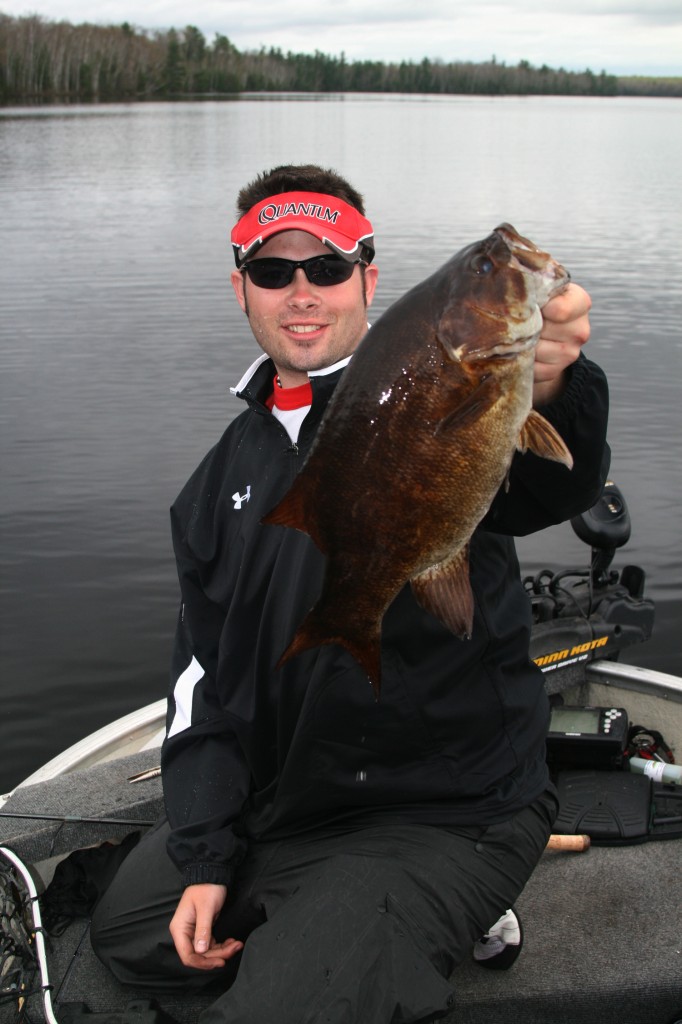 Smallmouth bass provide outstanding fishing opportunities throughout the year, with the annual “Smalliefest” taking place a week after the May season opener lasting through the first two weeks of June. Don’t get me wrong, good fishing persists throughout summer and fall, but becomes challenging as fish are always on the move which is a characteristic of these river system fish.
Smallmouth bass provide outstanding fishing opportunities throughout the year, with the annual “Smalliefest” taking place a week after the May season opener lasting through the first two weeks of June. Don’t get me wrong, good fishing persists throughout summer and fall, but becomes challenging as fish are always on the move which is a characteristic of these river system fish.
TFF smallmouths are exceptionally heavy fish for their length, and robust in girth. They’re a unique genetic strain of smallmouth that I have seen nowhere else in the state. Commonly referred to as footballs, their growth rates are incredibly fast for this species as fish commonly reach 14 inches in length by year-3. Average length fish run 14 to 18 inches with few ever surpassing the 20 inch mark due to their short life spans. However, if you catch one around 17 and 18 inches, I guarantee you that it’s going to be a four pounder. There is no doubt in my mind that fish over 20 inches roam the vast acreage of the TFF. If encountered, they will be very old fish that are in the 7 to 8 pound range.
Served by six major public boat landings, over 100 DNR managed campsites, and special angling regulations, the Turtle Flambeau Flowage offers anglers immediate access to some of the best inland bass fishing in the entire state. These qualities, which have been greatly influenced by the Wisconsin Valley Improvement Company and Turtle Flambeau Flowage Scenic Waters area, have made it one of the most affordable, timeless, quality and pristine trips a diehard smallmouth bass angler can make. Because of its unique character and outstanding aesthetics, anglers can be assured of the TFF’s continued status as one of the best smallmouth paradises one can enjoy. Turtle Flambeau Flowage – http://www.turtleflambeauflowage.com
1 – Lake of the Woods, Northwest Ontario
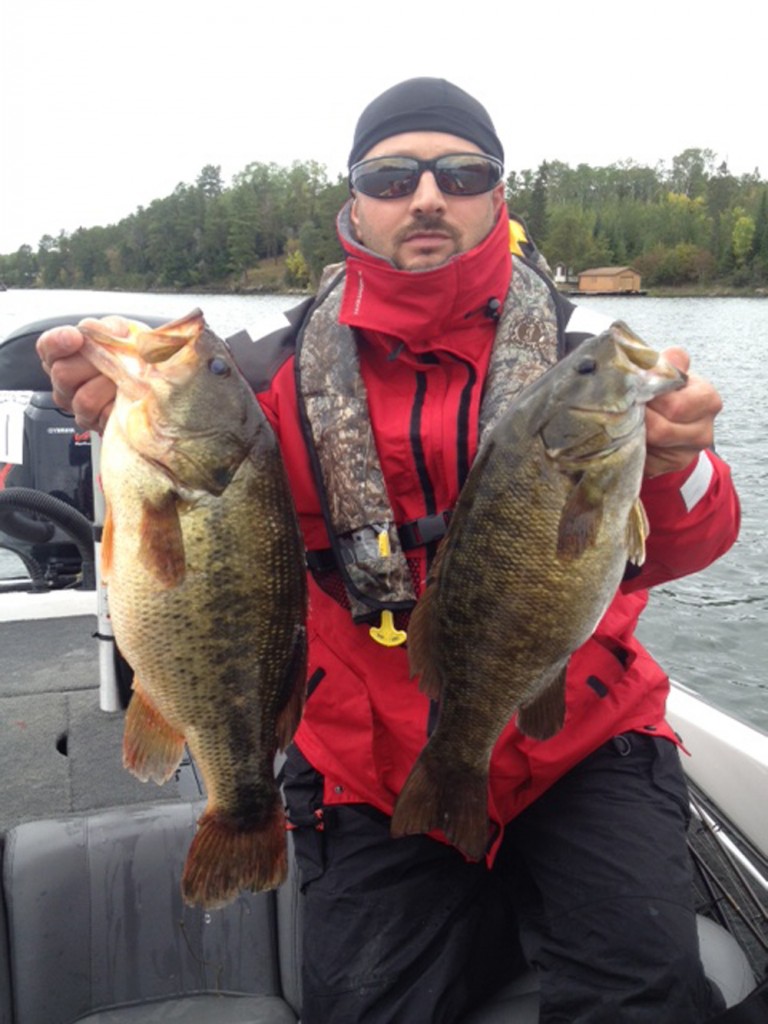
For many years, Canada has become synonymous with brown bass. While many of Northwestern Ontario’s smallmouth bass originated as immigrants from the railroad stocking days, they are naturalized Canadian citizens today.
With the exception of its three large, clear, bay-like sections, Lake of the Woods is characterized by dark, cola colored water. While the lake contains a healthy cisco and smelt population, it features an infestation of rusty crayfish that has decimated the lake’s original forests and jungles of cabbage beds. As a direct result, smallmouth populations quickly took off, and outstanding populations of fish are sustained by this abundant invasive forage.
Despite having exclusively fished muskies for a full week in August 2012, I experienced first hand what LOTW has to offer as far as smallmouth bass fishin potential is concerned. It features a number of aggressive 12 to 16 inch fish along with plentiful numbers of 18 to 20 inchers. Though they won’t be as monstrous as the trophies of the Great Lakes, and inland waters of Wisconsin and Minnesota, LOTW smallies will regularly reach 4 to 5 pounds.
From Kenora to the Northwest Angle, Warroad to Morson, Sioux Narrows, Nestor Falls, and everywhere else in between, Lake of the Woods always has something different to offer when it comes to its bass fishing. According to Ontario FLW pros Daryl Galusha and Jake Peacock, “You haven’t been on Lake of the Woods for smallmouth bass until you fish the clear waters around Sioux Narrows.”
Although I started fishing here in summer 2012 for its renowned muskies, Lake of the Woods contains a smallmouth bass fishery that is to be reckoned with. Due to abundant forage, endless acreage, natural and pristine shoreline areas, breathtaking rock bluffs and undisturbed habitat, Lake of the Woods will always remain as one of the top ten smallmouth bass fishing lakes in North America. Simply put, the amount of water and diversity of habitat is unreal, unrivaled, and cannot be experienced anywhere else in North America. It’s definitely overwhelming, but you will never see yourself ever becoming bored out there. Characteristics, as such, serve my primary driver for any future smallmouth bass trip I will make here. Lake of the Woods, MN – http://lakeofthewoodsmn.com LOTW Tourism – http://www.lakeofthewoods.com
Due to amount of content in this big smallmouth infatuated article, part II of this epic story will be featured separately in the next few days.


